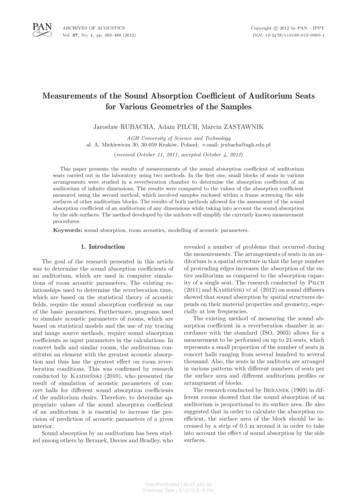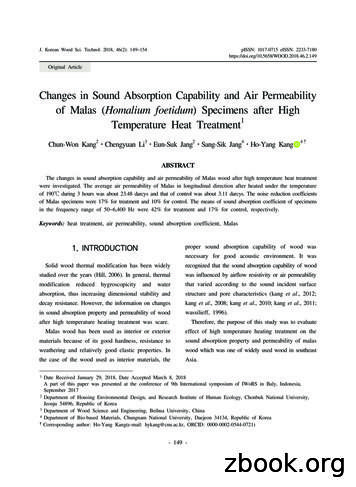ABSORPTION COEFFICIENT
Visit www.padeepz.net for notes and important questionABSORPTION COEFFICIENTWe know that all the sound waves when pass through as open window passesthrough it. Thus, we can say that the open window behaves as a perfect absorberof sound and hence the absorption coefficient can be defined as the rate of soundenergy absorbed by a certain area of the surface to that o an open window of samearea.Definition: The absorption coefficient of a surface is defined as the reciprocal ofits area which absorbs the same amount of sound energy as absorbed by a unit oan open window.For example if 2m2 of a carpet absorbs the same amount of sound energy asabsorbed by 1 m2 of an open window, then the absorption coefficient of the carpetis 1.2 0.5. The absorption coefficient is measured in open window unit (O.W.U)or Sabines.1 Average absorption coefficientThe average absorption coefficient is defined as the ratio between the totalabsorption in the hall to the total surface area of the hall.2 Measurement of sound absorption coefficientLet us consider a smaple for which the absorption coefficient (am) is to bemeasured. Initially without this material the reverberation time in a room andagain the reverberation time is measured and let it be T2.Then rom Sabine’s ormulaFor Case (1) i.e. without the sampleVisit www.padeepz.net for notes and important question
Visit www.padeepz.net for notes and important questionHere, by knowing the terms on the right hand side the absorption coefficient ofthe given sample can be determined.3 ACTORSBUILDINGAFFECTINGTHEACOUSTICSOFWe know, when sound waves are produced in a hall, it reaches the observerdirectly as well as after reflections from walls, floors, ceilings, etc. Thus there isa possibility for causing interference between these waves, which in turn affectsthe originality of the sound produced.The actors affecting the acoustics (sound) of building are as follows.i.Unoptimised reverberation timeii.Very low or very high loudnessiii.Improper focusing of sound to a particular area, which may causeinterferenceiv.Echoes or echelon effects produced inside the buildingsv.Resonance caused due to matching of sound waves.Visit www.padeepz.net for notes and important question
Visit www.padeepz.net for notes and important questionvi.1.2.3.4.Unwanted sound rom outside or inside the building, so called noisemay also affect the acoustics o buildings.3.1 OPTIMUM REVERBERATION TIME AND ITS REMEDYWe know Reverberation time is the taken for the sound to fall to one milliontho its original sound intensity, when the source of sound is switched off.This reverberation time is high then it produces, echoes in the hall and if thereverberation time is very low, the sound will not be cleary heard by theaudience. Therefore, for clear audibility, we should maintain optimumreverberation.The optimum reverberation time can be achieved by the following stepsBy having the full capacity o audience in the auditorium.By choosing absorbents like felt, fiber, board, glass etc inside the auditorium andeven at the back of chairs.Reverberation time can be optimized by providing windows and ventilators at theplaces wherever necessary and using curtains with folds or the windows.The reverberation time can also be optimized by decorating the walls withbeautiful pictures.The optimum reverberation time will not be constant for all types of building;it varies from one building to another as follows.i.For concert halls, the speech should have the optimum reverberationtime of 0.5 seconds and music should have the optimum values o 1 or 2secondsii.For auditorium, or theatres, the optimum reverberation time should bebetween 1.1 to 1.5 seconds for smaller area and between 1.5 to 3seconds for larger area.3.2 Loudness and its remedy:We know loudness is the degree of sensation produced on the ear; it variesfrom observer to observer. But, it is found that for a single observer theloudness varies from one place to another in the same auditorium. This defectis caused due to the bad acoustical construction of buildings.The loaudness will be very low in some area and will be very high in someareas. It can be optimized by the following remedies.Remediesi.Loudspeakers should be placed at the places where we have lowloudness.ii.The loudness can also be increased by making reflecting surfaces,wherever necessaryiii.Loudness can be increased by constructing low ceilingsiv.Absorbents are placed at the places where we have high loudness.Thus, the loudness should be made even, all over the auditorium, so that theobserver can hear the sound at a constant loudness at all the places.Visit www.padeepz.net for notes and important question
Visit www.padeepz.net for notes and important question3.3 FOCUSSING AND INTERFERENCE EFFECTSIn some places of a hall, the sound will not be heard properly and that place issaid to be a dead space, which is due to presence of convex or concave surfacesin the hall as shown in the figure. Sometimes the sound waves will haveinterference pattern because of ceiling surfaces which will create maximumintensity of sound(due to constructive interference) in some places andminimum intensity of sound(due to destructive interference) at some placesand hence causing uneven distribution of sound intensity in the hall and hencecausing uneven distribution of sound intensity in the hall.Remediesi.By avoiding curved surfaces (or) covering the curved surfaces bysuitable absorbents the focusing can be avoided.ii.By evenly polishing and decorating with absorbents the interferenceeffects can be avoided.3.4 ECHOES AND ECHELON EFFECTIn some halls, the walls o the halls will scatter the sound waves rather thanreflecting it, thus way create nuisance effect due to echoes. The echoes areformed when the time interval between the direct and reflected sound wavesare about 1/15th of a second. This effect occurs due to the reason that thereflected sound waves reaches the observer later than the direct sound.If there is a greater repetition of echoes of the original sound to the observerthen the effect is called as Echelon effect.RemediesThe echo can be avoided by lining the surfaces with suitable sound absorbingmaterials and by providing enough number of doors and windows.3.5 RESONANCEResonance occurs when a new sound note of frequency matches with standardaudio frequency. Sometimes, the window panel, sections of the woodenportion is thrown into vibrations to produce new sounds, which results ininterference between original sound and created sound. This will createdisturbance to the audience.RemediesVisit www.padeepz.net for notes and important question
Visit www.padeepz.net for notes and important questioni.The resonance effect can be avoided by providing proper ventilationand by adjusting the reverberation time to the optimum level.Nowadays the resonance is completely eliminated by air conditioningthe halls.ii.3.6 NOISENoise is an unwanted sound produced due to heavy traffic outside the hallwhich leads to displeasing effect on the ear. There are three types of noises.i.Air Borne noiseii.Structure Born Noiseiii.Inside NoiseAll these three noises pollute the area at which it has been produced and createharmful effects to the human beings. Fortunately human beings have thecapability to reject the sound within certain limits with conscious efforts andto carry on his normal work. But sometimes the noises are strong which resultsin the following effects.3.7 EFFECTS PRODUCED DUE TO NOISE POLLUTION It produces mental fatigue and irritation.It diverts the concentration on work and hence reduces the efficiencyof the work. It sometimes affects the nervous system and lowers the restorativequality of sleep. Some strong noises leads to damage the eardrum and make the workerhearing impaired. The noises which are produced regularly will even retard the normalgrowth of infants and young children.a. AIR BORNE NOISEThe noise which reaches the hall through open windows, doors, andventilations are called as air borne noise. This type of noise is produced bothin rural areas [natural sound of wind and animals] and in urban areas] noisethat arises from factories, aircrafts, automobile, trains, Flights etc.REMEDIESi.By making the hall air conditioned, this noise may be eliminatedii.By allotting proper places or doors and windows, this noise can bereduced.iii.It can be further by using double doors and windows with separaterames and by pacing the absorbents in-between themb. STRUCTURE BORNE NOISEVisit www.padeepz.net for notes and important question
Visit www.padeepz.net for notes and important questionThe noise that reaches the hall through the structure of the building is termedas Structure Borne noise. Those types of noise produced inside the building,which may be due to the machinery operation, movement of furniture’sfootsteps etc and these sounds will produce structural vibration giving rise tothe Structure Borne Noise.REMEDIESi.By properly breaking the continuity of the interposing layers by someacoustical insulators this type of noise can be avoided.ii.By providing carpets, resilent, antivibration mounts etc., this type ofnoise can be reduced.c. INSIDE NOISEThe noises that are produced inside the halls is known as inside noise. Orexample in some offices the sound produced by machinery, type writers ectproduces this type of noise.REMEDIESi.By placing the machineries and type writers over the absorbing materialsor pads this type of noise can be reduced.ii.It can be reduced by covering the floors with carpet.iii.By fitting the engine on the floor with a layer of wood or elt betweenthem this type of noise can be avoided.4 FACTORS TO BE FOLLOWED FOR GOODACOUSTICS OF BUILDINGTo have a clear audibility of sound have an optimum leveli.The reverberation time should have an optimum levelii.The sound must be evenly distributed to each and every part of thebuilding.iii.There should not be any focusing of sound to any particular area.iv.Each and every syllable of sound must be herd clearly and distinctly,without any interference.v.There should not be any echoes, echelon effects and resonance insidethe buildings.vi.The building should be made as sound proof building, so that externalnoises may be avoided.vii. Generally to say the total quality o sound should be maintained all overthe building to all the audience.Visit www.padeepz.net for notes and important question
ion coefficient. The average absorption coefficient is defined as the ratio between the total absorption in the hall to the total surface area of the hall. 2 Measurement of sound absorption coefficient. Let us consider a smaple fo. r which the absorption coefficient (a. m) is to be measured.
Note: The exctinction coefficient is related to the absorption coefficient by α 4 πk / λ0 , where α is the absorption coefficient, k is the extinction coefficient, and λ 0 is the wavelength in vacuum. Acrylic Wavelength λ (nm) Refractive index n (-) 370 1.51259 380 1.51066 390 1.50891 400 1.50731 410 1.50584 420 1.50449 430 1.50324
sound absorption coefficient. The tests were carried out using recycled glass wool of 15mm thicknesses. Fig. 3 - Tested glass wool samples 15 mm . The absorption coefficient is a function of frequency and was determined on 1/3 octave bands. The graphs in Fig. 4 represent the measured absorption coefficient.
SOUND ABSORPTION COEFFICIENT PER ASTM C423-09A Measurement of sound absorption coefficient by the reverberation room method Report number: 17-159-M16 Date 2017-06-07 Frequency f [Hz] Sound absorption coefficient 50 0.01 63 0.01 80 0.06 100 0.05 125 0.09 160 0.15 200 0.23 250 0.34 315 0.42 40
for small P/S values the sound absorption coeffi-cient values are also small, which is due to the fact that in blocks with large surface areas the effect of sound absorption by side surfaces of the auditorium is smaller. Fig. 1. Sound absorption coefficient α of seat 2 as a function of the perimeter to surface area ratio P/S.
phenomenon will be referred to as "air absorption" and the intensity attenuation coefficient m is used. B. Air absorption in room acoustic prediction modeling Most statistical calculation models that predict the reverberation time, for instance, Sabine's and Eyring's equa-tion, take into account the air absorption by the factor m:
(or index of refraction) Absorption coefficient 0 Absorption coefficient α energy decay coefficient, after distance L : e –2 α L E.g. vacuum n 1, air n 1; glass n 1.5; glass fiber has α 0.25dB/km 0.0288/km MIT 2.71/2.710 Review Lecture p-6
The means of sound absorption coefficient of specimens in the frequency range of 50 6,400 Hz were 42% for treatment and 17% for control, respectively. Keywords: heat treatment, air permeability, sound absorption coefficient, Malas
Accounting information and managerial work. Accounting, Organizations and Society, 35 (3), 301-315. ABSTRACT . Despite calls to link management accounting more closely to management (Jonsson, 1998), much is still to be learned about the role of accounting information in managerial work. This lack of progress stems partly from a failure to incorporate in research efforts the findings regarding .























